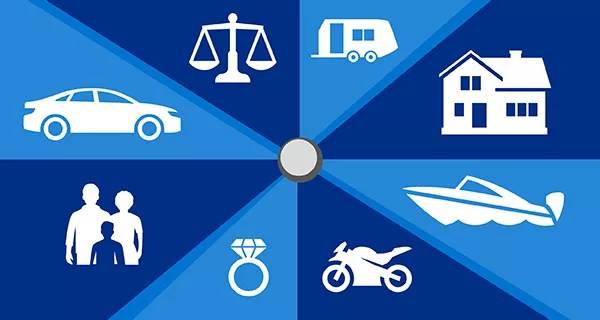AUTO INSURANCE: A COMPREHENSIVE OVERVIEW
Introduction
Auto
insurance is a critical component of vehicle ownership and a legal requirement
in many parts of the world. It provides financial protection against potential
risks associated with owning and operating a vehicle. This protection can come
in the form of liability coverage, comprehensive coverage, collision coverage,
and more. In this guide, we will explore the different types of auto insurance,
the factors that affect auto insurance rates, and the benefits of having
adequate coverage.
What is Auto Insurance?
Auto
insurance is a contract between a vehicle owner and an insurance company, where
the vehicle owner pays regular premiums in exchange for coverage against
financial loss due to various circumstances, including accidents, theft,
vandalism, and other vehicle-related incidents. Depending on the policy, auto
insurance can cover the costs of repairs, medical bills, legal fees, and damage
to property.
Types of Auto Insurance Coverage
There
are several types of auto insurance coverage that provide protection in
different scenarios. Understanding the types of coverage available is crucial
for both drivers and vehicle owners, as it allows them to select the right
policy to meet their needs.
1. Liability Insurance
- Bodily Injury Liability: This covers the medical
expenses, lost wages, and legal fees for people injured in an accident
caused by the policyholder. It does not cover the policyholder's medical
expenses but protects them from financial liability for injuries they
cause to others.
- Property Damage Liability: This covers the cost of
repairing or replacing the property that the policyholder damages in an
accident, such as another person's vehicle, fence, or building.
Importance:
- Liability insurance is often legally required in most
places and is essential for protecting drivers from significant financial
exposure in case they are at fault in an accident. This type of coverage
does not cover damage to your own vehicle, which is why additional
insurance options are necessary.
2. Collision Insurance
- Collision coverage pays for damage to your own
vehicle in the event of a collision with another vehicle or an object,
regardless of who is at fault. This coverage can help cover repair costs
or the replacement value of the vehicle if it is deemed a total loss.
Importance:
- Collision insurance is crucial for those who have a
vehicle loan or lease, as lenders typically require this coverage. It also
provides peace of mind for those who want to protect their investment in
their vehicle from potential accidents.
3. Comprehensive Insurance
- Comprehensive coverage protects your vehicle from
non-collision-related damage, such as theft, vandalism, natural disasters,
falling objects, and animal collisions. This insurance is useful for
covering damages that do not result from an accident but still cause
significant financial loss.
Importance:
- Comprehensive insurance is often recommended for new
or expensive vehicles, as it helps protect against unexpected events
beyond the driver's control. It also covers damages that may not be
related to a collision, such as theft or natural disasters.
4. Personal Injury Protection (PIP)
- PIP, also known as no-fault insurance, covers medical
expenses, lost wages, and other associated costs for the driver and
passengers after an accident, regardless of who was at fault. It can also
cover funeral costs in the event of a fatal accident.
Importance:
- PIP is particularly useful in no-fault states, where
drivers are required to carry personal injury protection to avoid lengthy
legal battles over who caused the accident. This coverage ensures that
medical bills are paid quickly and without the need to prove fault.
5. Uninsured/Underinsured Motorist Coverage
(UM/UIM)
- This coverage helps protect you if you are involved
in an accident with a driver who does not have insurance or does not have
enough insurance to cover the costs of the damage. It can also protect you
from hit-and-run accidents.
Importance:
- UM/UIM coverage is crucial, as it provides protection
in scenarios where the other driver is either uninsured or does not have
enough coverage to pay for your medical expenses or vehicle repairs. This
type of coverage ensures that you are not left financially vulnerable in
such cases.
6. Gap Insurance
- Gap insurance covers the difference between what you
owe on your vehicle and the vehicle’s current market value in the event of
a total loss. It is particularly useful for new cars that depreciate in
value quickly.
Importance:
- Gap insurance is recommended for those who have
financed or leased a new car, as the vehicle’s value can drop
significantly in the first few years. If your vehicle is totaled, gap
insurance can ensure that you do not owe more than the vehicle is worth.
Factors Affecting Auto Insurance Rates
Several
factors influence the cost of auto insurance premiums. Insurance companies
evaluate these factors when determining how much to charge for coverage.
Understanding these factors can help you manage your insurance costs
effectively.
1. Driving Record
- A clean driving record with few or no traffic
violations or accidents will generally result in lower premiums.
Conversely, if you have a history of speeding tickets, DUIs, or accidents,
your rates will likely be higher.
Impact:
- Drivers with a history of accidents or traffic
violations may be considered higher-risk by insurers, leading to increased
premiums.
2. Age and Gender
- Younger drivers, especially teenagers, often pay
higher premiums due to their higher risk of accidents. In many places,
men, particularly those under 25, tend to be charged higher premiums than
women, as statistics show that men are more likely to be involved in
accidents.
Impact:
- Younger drivers and male drivers generally face
higher insurance costs, although rates typically decrease with age and
experience.
3. Type of Vehicle
- The make, model, and year of your vehicle will affect
your premiums. Luxury cars, sports cars, and vehicles that are expensive
to repair or replace often come with higher insurance rates. On the other
hand, vehicles that are considered safer or more fuel-efficient may result
in lower premiums.
Impact:
- The higher the vehicle's cost and the greater the
risk of theft or expensive repairs, the higher the insurance premiums.
4. Location
- The location where you live can significantly affect
your auto insurance rates. Areas with high traffic congestion, higher
rates of accidents, or higher instances of theft may have higher insurance
costs. Rural areas, on the other hand, often see lower insurance premiums
due to lower risks of accidents.
Impact:
- Urban dwellers tend to pay higher premiums than rural
residents, as traffic-related risks and the chance of accidents are higher
in urban settings.
5. Credit History
- Many insurers use your credit history as a factor in
determining premiums. Research shows that individuals with higher credit
scores tend to file fewer claims, which translates to lower insurance
costs.
Impact:
- Drivers with poor credit may face higher insurance
rates, while those with better credit histories often receive discounts.
6. Mileage and Usage
- The amount of time you spend driving each day and how
often you use your vehicle affects your rates. Drivers who commute long
distances or use their vehicles for business purposes are typically
charged more because they are at a higher risk of accidents.
Impact:
- The more you drive, the higher your risk of
accidents, which could increase your premiums. Those who use their vehicle
sparingly may qualify for lower rates.
Benefits of Having Auto Insurance
Auto
insurance provides numerous benefits beyond just financial protection in the
event of an accident. Here are some of the key advantages of having auto
insurance:
- Financial Protection: Auto insurance can cover the
cost of repairs, medical bills, legal fees, and property damage,
protecting you from significant financial losses.
- Peace of Mind: Knowing that you are covered in case
of an accident or damage to your vehicle can provide peace of mind and
reduce stress.
- Legal Compliance: In many countries and states,
having at least liability insurance is a legal requirement. Failing to
maintain insurance can result in penalties, fines, or even the loss of
your driving privileges.
- Protection Against Uninsured Motorists: If you are
involved in an accident with a driver who lacks insurance or sufficient
coverage, uninsured motorist coverage can protect you financially.
- Medical Coverage: In addition to liability coverage,
personal injury protection (PIP) or medical payments coverage can help
cover medical expenses for you and your passengers.
Conclusion
Auto
insurance is an essential part of responsible vehicle ownership, providing
financial protection and peace of mind in the event of accidents, theft, or
other unexpected incidents. By understanding the different types of coverage,
the factors that affect premiums, and the benefits of auto insurance, drivers
can make informed decisions about their insurance needs and find the best
coverage for their circumstances.
In
a world where accidents can happen at any time, having the right auto insurance
policy can help you avoid significant financial hardship and ensure that you
are protected in the event of a collision, theft, or other incidents.


